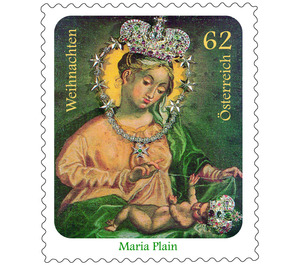Christmas - Austria / II. Republic of Austria 2011 - 62 Euro Cent
Theme: Religion & Spirituality
| Country | Austria / II. Republic of Austria |
| Issue Date | 2011 |
| Face Value | 62.00 |
| Edition Issued | 3,624,000 |
| Printing Type | offset |
| Stamp Type | Commemorative |
| Item Type | Stamp |
| Chronological Issue Number | 2303 |
| Chronological Chapter | OOS-OE2 |
| SID | 718835 |
| In 47 Wishlists | |
The painting of Our Lady of Plain with the title "Consolatrix afflictorum" (Comforter of the Afflicted) is an about 40 x 50 cm large oil painting of an unknown German Baroque painter, which was created before 1633 in the Regensburg area. His oldest description as a Christmas picture comes from Rudolf Grimming von Niederrain from 31.12.1652: "A panel of our dear women picture, so that khindlein has ligendt before her." One sees - without the attached in 1751 crowns, the star wreath and a gemstone occupied To take into account the colleague with the Maltese cross - the half-image of the Blessed Mother in a simple dress and a green-blue cloak as she lifts a transparent veil from both hands in front of her naked boy Jesus to show it to the beholder. The gaze of the Madonna lowers to the child, while his mother holds out both hands. Maria's head is surrounded by a Nymbus; her partially parted hair, partially covered with a veil, is blond and has two tied braids over her right ear. The unknown master did not invent the picture composition himself; it goes back to the so-called "Madonna di Loreto" of 1511/1512 by the famous painter Raffaelo Santi di Urbino. The Plainer miraculous image appears reversed to the Raffael original, which has been in the Condé museum in Chantilly since the days of Napoleon I, and the contemplative St. Joseph was omitted. The original "Madonna di Loretto" represents a foundation of Pope Julius II della Rovere for the Basilica of Santa Maria del Popolo in Rome, the veil's quotation being an allusion to the relic of the Velvet of St. Veronica from the Passion of Christ points. On the Plainberg, which delimits the valley basin of the city of Salzburg towards the north, rises since 1673 a two-towered Baroque church, from which the panorama of the city in front of the magnificent backdrop of the Unterberg, the Tennen- and Hagengebirges up to the Upper Bavarian hill country in front of the Viewer spreads. In this house of worship is that Salzburg Marian Shrine, which has not diminished since Immakulatatag 1652 until today, the faithful people a "comforter of the afflicted", the "salvation of the sick" and a "Help of Christians" - as far as the titles of the Madonna " Lauretian Litany "- to be.


